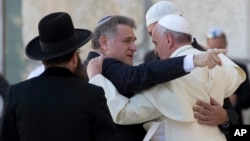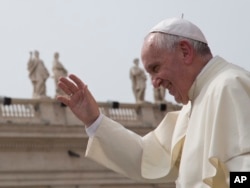In 2006, before he was Pope Francis, Archbishop Jorge Bergoglio of Buenos Aires was invited to an open-air Pentecostal worship service in the Argentine capital.
Argentina was, and still is, a hive of intensely charismatic evangelical Christianity – which for decades has been poaching Catholics from the church throughout Latin America. The Luna Park stadium was filled with some 7,000 worshippers. The preachers asked Bergoglio if they could pray for him.
“The first thing that occurred to me was to get on my knees, a very Catholic gesture, to receive their prayer,” the archbishop recalled in "On Heaven and Earth," a book of dialogues he published in 2010 with his friend, Argentine Rabbi Avraham Skorka.
Traditionalist Argentine Catholics were outraged. Some accused him of committing the sin of apostasy by praying with people of another faith. But Bergoglio believed that a Catholic should be able to pray even with an agnostic.
“With his doubt, we can look up together to find transcendence; each one praying according to his tradition,” the archbishop told the rabbi and, directing himself to his critics, he added: “What’s the problem?”
The pope's style
Those three words, “What's the problem?” in a 220-page book, may have been a foreshadow of the “Who am I to judge?” answer he gave, as pope, when asked about gays. The question has become symbolic of this pope's pastoral style.
But his no-big-deal take on ecumenical prayer is also a reminder that, aside from being the first Latin American pontiff, Francis is really the first one who has pastored extensively in a multi-faith environment, and lived out the ecumenical spirit set out by the Second Vatican Council of the 1960s.
It is easy to forget that before that transformative council, pope after pope inveighed against ecumenical activities, and that some Catholics are still opposed. After "On Heaven and Earth" was published in the United States, Francis' decision to accept an evangelical blessing was condemned by the arch-traditionalist newspaper Catholic Family News, which calls joint prayers “the greatest error of our age.”
Post-Vatican II popes have been ecumenical, but not all got it right: when Benedict XVI cited a Byzantine emperor's anti-Islamic polemic in a 2006 speech at the University of Regensburg in Germany, violence broke out in several Arab countries. Benedict later apologized and said it was not his own view.
Learn from other faiths
One of the iconic images of Francis' papacy so far is at the Western Wall in Jerusalem – a symbol of Jewish suffering and hope – where he was photographed embracing both Rabbi Skorka and the Argentine Imam Omar Abboud.
Rev. Thomas Reese of the "National Catholic Reporter" says Francis' message to Catholics is not just to talk to people of other faiths, but learn from them too.
“In fact, he believes that Catholicism can learn from the evangelicals: We have to be more Gospel-based in our preaching, we have to be more experimental, we have to get out of church and go preach in the streets,” Reese says. “Rather than feeling threatened by other religious groups, he wants to reach out, he wants to be in dialogue.”
He will be able to do that in United States as well.
On Friday, the pope will attend a multireligious service at the 9/11 Memorial and Museum in New York City – where 2,606 Americans were killed by a group of Muslims who militantly believed theirs was the only true faith.
Francis' outlook stems from Argentina being a land of many cultures – and varieties of religious experience – largely as a result of immigration that parallels what happened in the United States, says Austen Ivereigh, author of "The Great Reformer, Francis and the Making of a Radical Pope."
As a consequence, Ivereigh says, Francis understands multiculturalism the way Americans do.
“He was born of Italian immigrants who could just as easily have come to New York or Philadelphia, but they went to Buenos Aires during that great age of immigration,” says Ivereigh. “There's an awful lot in common between his own background, and the background of Americans.”









